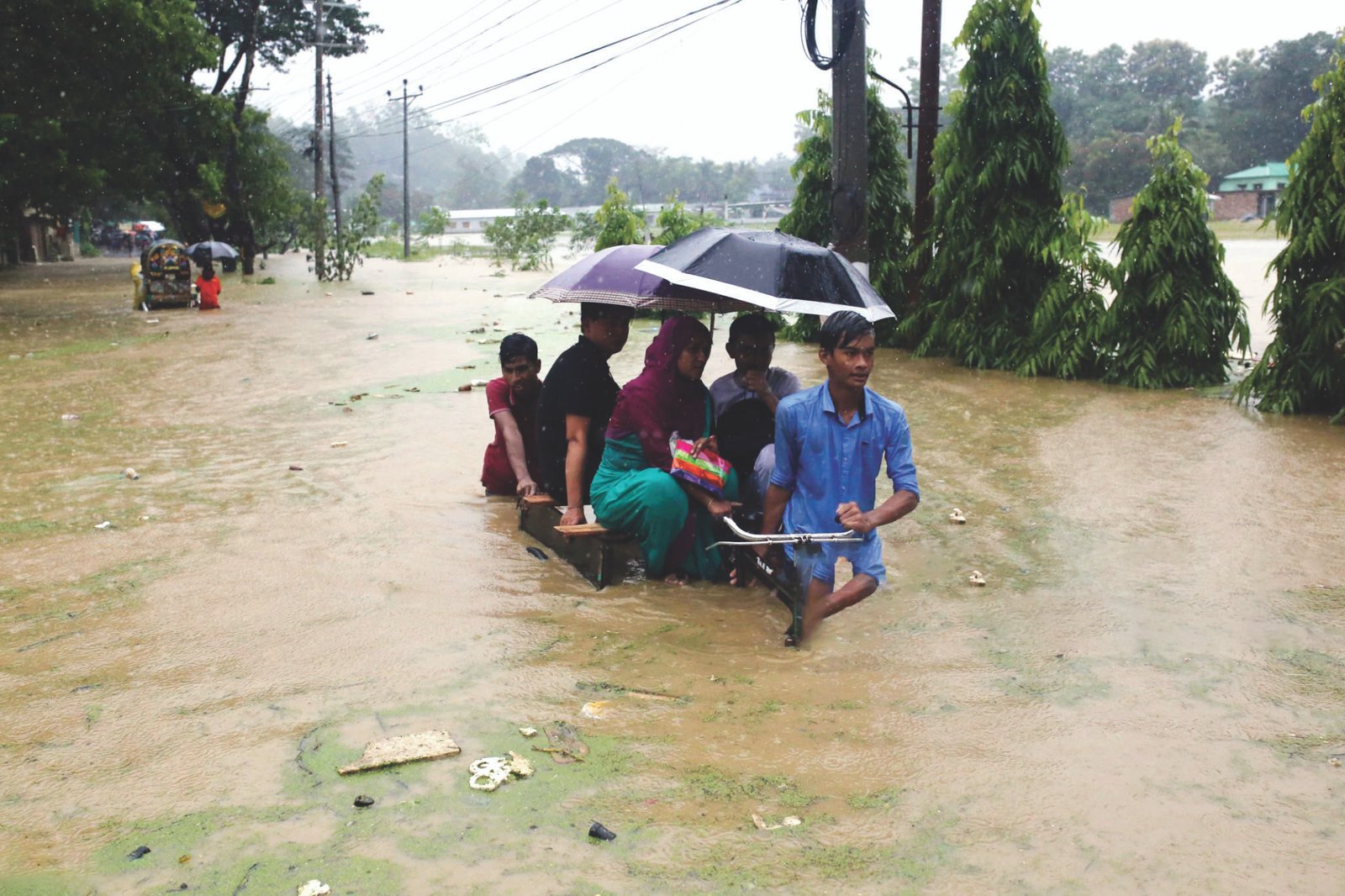
Climate finance is the lifeblood of the global response to climate change, encompassing local, national, and transnational funding flows to support mitigation and adaptation actions. Rooted in the principle of Common but Differentiated Responsibilities and Respective Capabilities (CBDR-RC) under the UNFCCC, it represents a critical equity issue, ensuring that vulnerable nations—which contributed least to the crisis—can cope with its devastating impacts.
Global Perspectives and Relationship with Bangladesh
The global climate finance architecture involves a multitude of actors, funds (like the Green Climate Fund and Adaptation Fund), and mechanisms. Developed nations are obligated to provide financial resources to assist developing countries. However, flows remain inadequate and often in the form of loans, creating debt risks.
Bangladesh stands at the nexus of the climate crisis and climate finance. As one of the world's most climate-vulnerable nations, facing rising sea levels, cyclones, and floods, its annual climate financing needs are substantial, estimated to be around 5.0% of its GDP annually. Bangladesh has shown proactive leadership by establishing its own Climate Change Trust Fund (CCTF) in 2009, using domestic resources and mainstreaming climate spending into its national budget. Despite these efforts and the funding received from development partners, UNFCCC windows, and multilateral development banks, a significant financing gap persists.
Impact of the New Collective Quantified Goal (NCQG) Outcome
The New Collective Quantified Goal (NCQG) on climate finance, set to succeed the unfulfilled $100 billion annual target from 2025, is a major pillar of the Paris Agreement. The NCQG aims to significantly increase the scale of global climate finance to align with the Paris Agreement's long-term temperature goal and support developing countries' Nationally Determined Contributions (NDCs) and National Adaptation Plans (NAPs). The final NCQG is a floor, and the agreed-upon figure is 1.3 trillion dollars. Out of that, only $300 billion is from developed countries; these countries are supposed to take the lead, according to the UNFCCC and the Paris Agreement. However, the quality of climate financing is another very crucial issue, particularly on adaptation financing. Implementation of the NCQG outcome must also focus on qualitative features like ensuring the finance is predominantly grant-based, easily accessible, providing preferential treatment for the climate vulnerable countries, and including specific provisions for Loss and Damage. Failure to do so would undermine the goal's potential impact and exacerbate climate-related debt.

Adaptation Financing: Quality, Quantity, Challenges, and Solutions
Adaptation finance flows to developing countries are vastly insufficient. The actual needs are estimated to be several hundred billion dollars annually by 2030, while current public flows are only in the tens of billions. The Glasgow Climate Pact goal of doubling adaptation finance by 2025 from 2019 levels is likely to be missed. A significant portion of adaptation finance is delivered as loans, which increases the debt burden on vulnerable countries, contradicting the principles of climate justice. Onerous and complex application, accreditation, and disbursement processes for multilateral funds, often requiring high institutional capacity that local and national entities lack. There is ample scope to simplify the process. Historically, climate finance has heavily favored mitigation projects over adaptation.
The probable solution might be in developed countries, and these countries must shift from loans to grants and highly concessional finance for adaptation, especially for the most vulnerable nations. Overhaul and simplify accreditation and project proposal requirements to enable direct access by national and sub-national entities. Dedicate specific funding windows and targets for Locally-Led Adaptation, channeling funds through local institutions and community-based organizations. Uphold the Paris Agreement's mandate to achieve a balance between adaptation and mitigation finance.
Loss and Damage Financing: Quality, Quantity, Challenges, and Solutions
The financing needed for Loss and Damage (L&D)—the unavoidable and irreversible impacts of climate change—is projected to be in the hundreds of billions annually by 2030, but current commitments, even to the new Loss and Damage Fund, remain a small fraction of this. L&D finance must be new, additional to existing aid and climate funding, and delivered predominantly as grants based on solidarity and climate justice.
The primary concern is that L&D finance will be diverted from existing Overseas Development Assistance (ODA) or other climate funds, rather than being truly new and additional. Establishing governance, eligibility criteria, and a delivery mechanism that is fast, flexible, and responsive enough for immediate disaster needs and slow-onset events remains a challenge. Reliance on voluntary contributions from a narrow base of developed countries is insufficient and unpredictable.
Probable solutions might be to explore and implement innovative sources of finance, such as global levies (e.g., on fossil fuel production, financial transactions, or aviation/shipping) or the use of Special Drawing Rights (SDRs) from the IMF. Ensure L&D funding is non-debt-creating, highly predictable, and based on the 'polluter pays' principle. The new Loss and Damage Fund must develop a simplified, non-project-based approach to disbursement that reaches the affected communities quickly, potentially through existing national and local systems with appropriate safeguards.
 copy.jpg)
The Role of Developed Countries and the Debt Crisis
Developed countries bear a primary responsibility for mobilizing climate finance due to their historical emissions. Their role must be transformative, fulfill and exceed the collective finance goals (the NCQG and the doubling of adaptation finance), and ensure timely, transparent, and predictable contributions. Prioritize non-debt-creating finance (grants) for both adaptation and Loss and Damage. Champion and contribute to innovative finance mechanisms that tap into new, reliable, and scaled-up sources beyond government budgets.
Addressing the Debt Crisis
The increasing provision of climate finance through loans risks creating an "adaptation investment trap" where developing countries become more indebted to prepare for a crisis they did not cause. Implement large-scale debt-for-climate swaps, converting external debt into finance for resilience projects. Integrate climate vulnerability into sovereign debt restructuring frameworks, allowing for debt standstills or forgiveness following major climate disasters. Ensure climate finance, particularly for adaptation and L&D, is delivered on grant terms or highly concessional to preserve fiscal space.
Addressing the Issue of Accessing Climate Financing
Access remains a formidable barrier, especially for the most vulnerable countries and local communities. Significant and sustained support for "readiness" and capacity building is needed to help developing countries prepare high-quality, bankable project proposals and navigate complex accreditation procedures. Multilateral and bilateral funds need to harmonize their application and reporting requirements to reduce the administrative burden on recipient countries. Promote and expand direct access modalities, which allow national entities to receive and manage funds, foster country ownership, and strengthen national systems.
Recommendations
To bridge the critical gaps in climate finance and deliver justice to countries like Bangladesh, the following strategic actions are recommended:
-
Mandate Grant-Based Finance for Vulnerable Countries: Developed countries must commit to providing at least 75% of all adaptation and 100% of all Loss and Damage finance to climate-vulnerable countries as grants, not loans, to halt the climate-driven debt crisis.
-
Transform the NCQG into a Justice Instrument: The NCQG should be based on a comprehensive assessment of needs, with a legally binding commitment to ensure balance between mitigation and adaptation, and explicitly include a substantial and grant-based Loss and Damage sub-goal.
-
Implement Innovative and Reliable Funding Mechanisms: Diversify funding sources beyond traditional aid. Key mechanisms to explore and implement immediately include:
-
Global Carbon Levies: Introduce small levies on global activities like international shipping, aviation, or fossil fuel extraction/production to create a predictable and independent revenue stream for Loss and Damage.
-
Special Drawing Rights (SDRs): Developed countries should channel a portion of their under-utilized IMF SDRs to the Loss and Damage Fund.
-
Global Carbon Levies: Introduce small levies on global activities like international shipping, aviation, or fossil fuel extraction/production to create a predictable and independent revenue stream for Loss and Damage.
-
Decentralize and Simplify Access: Overhaul the accreditation process for major climate funds (GCF, Adaptation Fund) to dramatically reduce complexity and time. Introduce a fast-track process for national and local entities in highly vulnerable countries.
-
Specific Solutions: Integrate climate vulnerability into all sovereign debt frameworks. Implement a mechanism for automatic debt standstills and explore large-scale debt-for-climate swaps (e.g., for Bangladesh) to free up fiscal resources for long-term resilience projects.
-
Enhance Transparency and Capacity: Invest heavily in "readiness support" programs focused specifically on project origination, fiduciary standards, and monitoring/evaluation (M&E) for adaptation and L&D, enabling countries to track fund effectiveness and build trust.
Conclusion
Climate finance is not merely a financial transaction; it is the ultimate test of global solidarity and climate justice. The current architecture, marred by insufficient quantity, poor quality (heavy reliance on loans), and complex access barriers, is profoundly failing the most vulnerable nations like Bangladesh. The chasm between the estimated adaptation and Loss and Damage needs—amounting to hundreds of billions annually—and the actual flow of funds is a catastrophic gap that is driving vulnerable economies into a dangerous "adaptation investment trap" of increasing debt.
The decision of New Collective Quantified Goal (NCQG) represents a critical juncture. Its success will not be measured by the headline number alone, but by its qualitative features: a massive shift to non-debt-creating finance (grants), a genuine balance between mitigation and adaptation, and a dedicated, accessible stream for Loss and Damage. Developed countries, by virtue of their historical responsibility, must move beyond incremental pledges and adopt a radical, rights-based approach to financial provision. Failure to do so will undermine the Paris Agreement's long-term goals and intensify global geopolitical tensions rooted in profound injustice. Climate finance must evolve from a promise of charity to a delivery of reparative justice to build a truly climate-resilient world.
Fazle Rabbi Sadeque Ahmed, Deputy Managing Director, PKSF, frsa1962@yahoo.co.uk
Download this Article As PDF/userfiles/EP_23_10_COPS_Rabbi.pdf
References
United Nations Environment Programme (UNEP). (2024). Adaptation Gap Report 2024: Come Hell and High Water. Nairobi: UNEP.
Independent High-Level Expert Group on Climate Finance. (2023). A Fair Share of Climate Finance. (Multiple reports).
UNFCCC Standing Committee on Finance (SCF). (2024). Fifth Biennial Assessment and Overview of Climate Finance Flows (BA).
International Monetary Fund (IMF) and World Bank. (Various Years). Global Financial Stability Report and Climate Change Country Profiles (Bangladesh).
Transitional Committee for the Operationalization of the New Funding Arrangements for Responding to Loss and Damage. (Final recommendations and institutional arrangements for the Loss and Damage Fund).
Overseas Development Institute (ODI) / Legal Response International. (2024). The New Collective Quantified Goal on Climate Finance and its access features.
World Bank. (2024). Second Bangladesh Green and Climate Resilient Development Credit and Climate Risk Country Profile: Bangladesh.
United Nations Framework Convention on Climate Change (UNFCCC). Paris Agreement (2015). Article 9 (Climate Finance) and the preamble's reference to Loss and Damage.
UNFCCC Conference of the Parties (COP) Decisions on the New Collective Quantified Goal (NCQG). (Specific decision text from COP29/CMA 6).



